
Galba tazza, ca. 1587–99. Netherlandish? Gilded silver. Figure: Casa-Museu Medeiros e Almeida, Lisbon; dish and foot: Schroder Collection, London
«In Part One of this interview, Cambridge classicist Mary Beard and Julia Siemon, curator of The Silver Caesars: A Renaissance Mystery, shared how they first became fascinated by the twelve silver cups known as the Aldobrandini Tazze, each of which visually embodies one chapter of an ancient Latin book by Suetonius about the first twelve sole rulers of Rome.
Describing the mystery surrounding the silver cups as "better than the thousand-piece jigsaw puzzle that you play at Christmas," Mary compared the orderly display of the newly reconfigured and reunited tazze to the real chaos of Roman history. Julia took us on a walk through the exhibition and explained how the Renaissance artists used not only the text of Suetonius but also antiquarian visual sources—such as prints, maps, and coins—to develop the imperial imagery on the cups.
Here, in Part Two, Mary and Julia look closely at the connections between the silver images and the Latin text, to see how the text affects our perception of the images, and how the images shape our understanding of the text.»
Sumi Hansen: Mary, you're here today to record a soundtrack for a video. Why is it important for us to hear the text of Suetonius read aloud while we look at the images on the cups?
Mary Beard: It gets us to see that to experience the tazze is to experience a text plus an image. You could put captions on the video, but it's much more vivid—and it really brings home some of the really precise observed detail—if you actually hear it.
Julia Siemon: Nero and the sweets!

Detail from the Nero tazza
He [Nero] made his way to the Palatine and the Temple of Apollo. Everywhere he went, animals were killed in sacrifice, lots of perfume was sprinkled onto the streets, and he was showered with birds, ribbons, and sweets. —Suetonius 25
Mary Beard: Nero has a naughty triumph, because the triumph is not for having bashed up the enemy, but because he's had some athletic victories in Greece. Suetonius talks about the crowds there throwing birds and ribbons and sweets. You look at the cup, and what they're throwing is birds, ribbons, and sweets!
Julia Siemon: The tazze are storytelling objects. The temporal aspect—and the act of telling the story—is essential. Some scenes have a telescoping chronology in which things happen in sequence within one image. If you don't know what you're looking at, you may see three different guys; but if you're reading Suetonius, you know it's one guy at three different points in the story. The only way to understand the tazze is as objects that were meant to be read; or, frankly, that were meant for a wealthy person to be sitting there looking at the cup while a scholarly advisor told the story.
Mary Beard: One of the ways of understanding them is as a scholarly conversation piece.
Julia Siemon: We have one juicy nugget that doesn't get explored in the exhibition because it was too complicated. There was a book that was sold and lost after 1893. It had 49 pages and was covered in green velvet, if you see it! This book was described in the sale as a description of the scenes on the tazze. There are 48 scenes on the cups, so the book must have been excerpted from Suetonius, telling you page-per-scene what was happening. We've been able to reconstruct part of what we suspect that book was like, digitally, through the process of creating the video.
Sumi Hansen: Mary, for the video you're reading aloud from a fresh translation of selected passages that you did for the exhibition. Can you give us a taste of the original Latin?
Mary Beard: Indeed I can. Here is Nero singing while Rome burns:
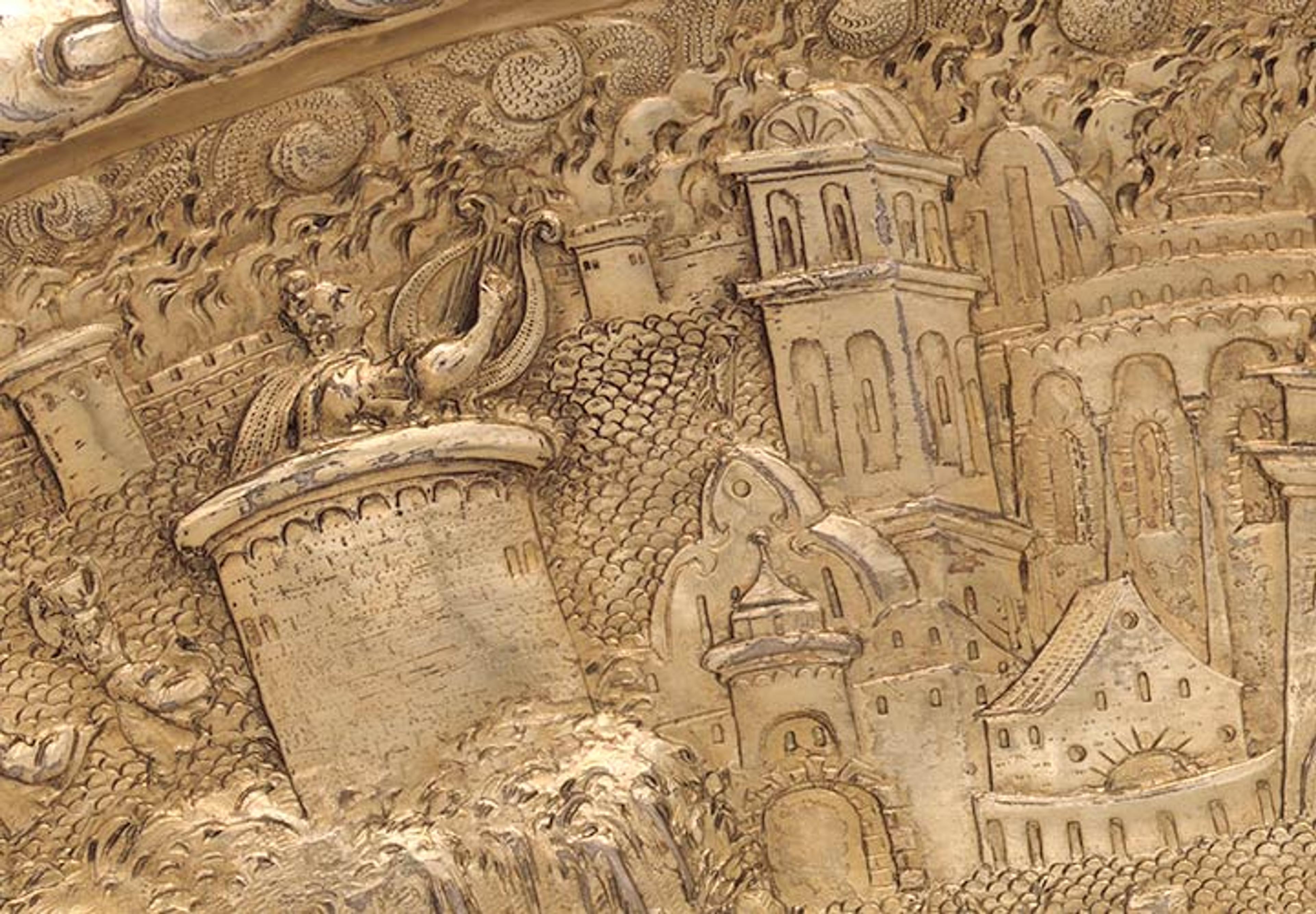
Per sex dies septemque noctes ea clade saeuitum est ad monumentorum bustorumque deuersoria plebe compulsa. . . . hoc incendium e turre Maecenatiana prospectans laetusque "flammae," ut aiebat, "pulchritudine," "Halosin Ilii" in illo suo scaenico habitu decantauit.
Through six days and seven nights, there was terrible destruction, while the people were forced to take shelter in monuments and tombs. . . . Looking at this blaze from the tower of Maecenas, he rejoiced, so he said, "in the beauty of the fire," and he sang "The Fall of Troy" in that stage costume of his. —Suetonius 38
Sumi Hansen: Can you share why you chose to do fresh translations, given that we have Robert Graves and other reliable translations of Suetonius?
Mary Beard: Copyright! [laughter] The precise choice of words. One of the things you're trying to do as a translator is help people see the scene. When you've got a visual image in mind, it helps you match up the text and the image in a way that the standard translation doesn't always do. I also have to say that every translation is done for a moment and for a time, and an awful lot of translations of ancient authors, excellent as they are, don't exactly make the heart sing. [laughter] Suetonius is too long dead to get the royalties on this, but we're trying to read him fresh and say, "Look! Suetonius is actually . . . !"
Sumi Hansen: The tazze translate the text of Suetonius into images. Would you say they offer a close translation or an active interpretation of the text?
Mary Beard: As a partisan classicist, I hope that when people come to see this show they might be encouraged to go back to look at Suetonius's Lives of the Caesars, even if it's to their Robert Graves translation. Because what you see here, whatever you make of it, is a major classical text being used, negotiated with, and adjusted to make this extraordinary work of art. There's a real active engagement here; it's not a passive illustration.
What's interesting from a classical point of view is that when we read Suetonius now, we read Suetonius for the naughty stories—what Tiberius did in the swimming pool with little boys (woops!)—and all the bad things—the murders, and the bad deaths, and the poisoning, and all the terrible things Caligula did. In a sense, for us, Suetonius has become a way of reading the excesses and transgression of Roman power. But whoever is excerpting and representing Suetonius in the tazze is reading him completely differently from that. It's extremely interesting that there's almost nothing bad going on. Yes, you've got Nero watching the fire of Rome, and you've got Caligula prancing on his horse across the bay at Baiae—which is not the worst thing Caligula did! But otherwise what this is is an extraordinary reading which picks out, first of all, the real successes of Roman power. So whenever the tazze can show a Roman victory or a triumphal procession, the ultimate celebration of Roman victory, they do.
Sumi Hansen: The cups manipulate narrative sequence, don't they, to flatter the emperors.
Mary Beard: It is very cleverly worked out. There are four individual scenes on each dish, so you know it's been quite heavily excerpted. It's not Suetonius chapter by chapter! You read the four scenes clockwise. Basically, the scenes go chronologically, in the Suetonian order—except for the triumph. If an emperor triumphs, not while he was prince but during his reign, that scene of triumph is taken out of sequence and put last so that the triumph becomes the culmination. This is absolutely systematic.

Detail from the Claudius tazza
It so happened that when he went into the Forum for the first time with the rods of office, an eagle that was flying by came to rest on his right shoulder. —Suetonius 7
The tazze are also extremely interested in showing the scenes about transmission of power. If I were to show my students these scenes—these are not the famous scenes in Suetonius. This is the time when Claudius was in the Forum and an eagle came and landed on his shoulder—an omen of imperial power. Most readers of Suetonius now don't remember that. So here you've got Suetonius being read to demonstrate the success of imperial power and the successful transmission of power. The Roman Empire is a very, very bad example to take of that, because they were hopeless at transmitting power. [laughter]
But here, you see, you can reconfigure what we would think of as the obvious reading of Suetonius to be about transmission. It forces you to back to look at Suetonius again. Because when we read Suetonius, we read it life by life. We sit down and think, "I'm going to read Suetonius's Life of Nero." You pick the lives that you think are going to be good: the bad ones, Caligula and Nero. Now, what these guys in the Renaissance are doing is reading Suetonius from cover to cover. They're reading Suetonius as a narrative not of a series of biographies of emperors, but as a narrative of dynasty, of success and succession, absolutely visualized. When you go back to Suetonius and you start to read it like that, you see that they were not wrong to read Suetonius like that. We think of it as a gossipy collection—and he is that, and that's how we now read him. But actually what he's doing is taking you through the way that Roman imperial power was transmitted, and all the difficulties there were in transmitting it.

Top left: Detail from the Claudius tazza. These men put him [Claudius] in a litter, and because his own servants had fled, they took it in turns to carry him and brought him, frightened and despairing, to the military base. —Suetonius 10
Bottom left: Detail from the Otho tazza. Then quickly getting into the kind of closed sedan chair that women use, he [Otho] made for the military base; but when the bearers began to flag, he got out and ran. —Suetonius 6
Bottom right: Aureus of Claudius showing a military base, A.D. 44. Rome. Gold, 18.5 mm, 7.05 g. American Numismatic Society, New York, E.T. Newell Bequest (1944.100.39353)
Julia Siemon: The tazze also use visual material to make connections between stories on separate tazze. In one case, there are two stories about different emperors whose power was given to them by the praetorian guard, the city troops. The moment in which the emperor is given power by the city troops is the second scene on both dishes. Both scenes involve a military base; and on both cups, that military base is taken from an ancient Roman coin. Claudius is being carried in a litter, and Otho is so excited he hops out of his chariot to run to the military base, but it's the same base, and essentially the same composition, and it's visually told exactly the same way. That parallel is not what you'd catch if you were just reading the stories in a book! You wouldn't say, "Oh, these are two people who were brought to power by the praetorian guard."
Mary Beard: When you see it on the tazze, it's a really important rereading. It made me look at Suetonius anew.
Julia Siemon: It's also cheating. I have to add, the cups cheat! My favorite example is Tiberius. There's a paragraph in Suetonius that starts (and of course I'm paraphrasing here), "Tiberius was such a greedy jerk, he never gave any money to anybody. He was totally uncharitable, and here are all the different ways in which he didn't give any money to anybody." But the last sentence says (again, in essence), "Fine, except for the one time where there was an earthquake in what is now Turkey and he sent some money." That's what's depicted on the tazza, as an important example of imperial generosity. So it is a deeply selective reading of the passage.
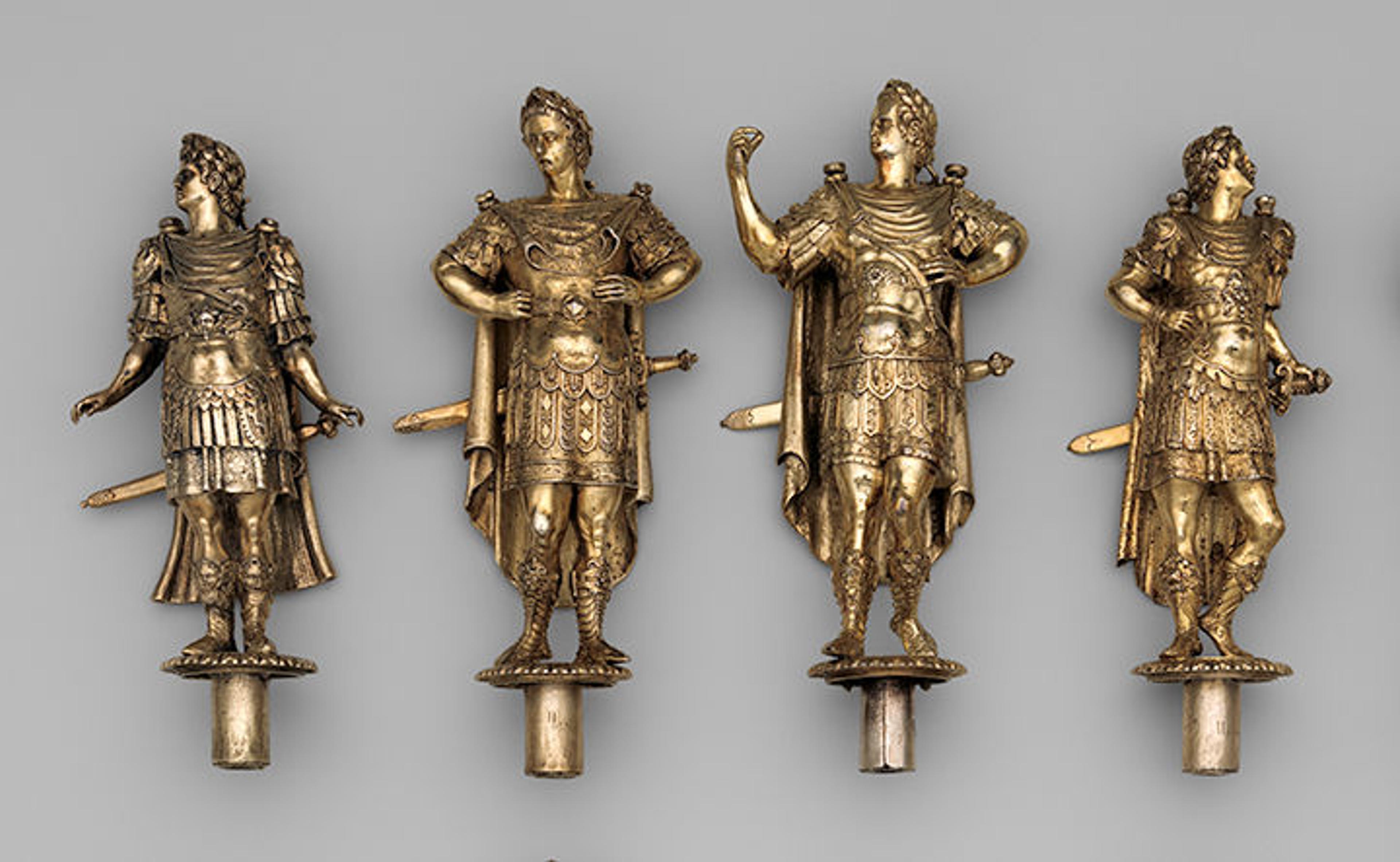
Figurines detached from bowls. From left to right: Augustus, Tiberius, Caligula, and Claudius
Sumi Hansen: Each figurine is engraved with the name of an emperor, and each bowl depicts scenes from his life. How could the bowls and figures ever get so mixed up?
Julia Siemon: It's easy to imagine. You take all of them apart and you're installing them, and you've got a row of twelve.
Mary Beard: And you think, "Oh sh**! Which one did we take off there? Oh god, no!"
Julia Siemon: They look very distinct when you get to know them, but when you don't know them! There was a team of artists. A number of people were involved, but each dish was clearly made by one person, and there are distinct styles. So for me, I might think, how could you possibly confuse the Julius with the Galba? Galba is super-naturalistic, while Julius has this kind of crazy horror vacui. But for someone else, I think it would be very easy to just go chuck-chuck-chuck.
Sumi Hansen: People were not doing close readings of either the images or the text.
Mary Beard: I think it's two things. At some point they get mixed up, and they're certainly being mixed up by people who have not got Suetonius next to them. It's the owner, it's the cleaning lady.
The second thing, though, is the obedience of the viewer. It's a nice case of the theory of the caption. Once you're told that's what it is, that's how you read it. It is very easy with any object at all to pretty much assume that when the guys writing about it saw it and were cataloguing it in the 1860s, they got it right. Your first instinct is not to say, "Well, I'm going to distrust everything I read!" It takes quite a long time to penetrate the mystery. It takes an enormous amount of effort to say, "That's not right."

Detail from the Vespasian tazza
On another occasion when he was dining, an ox that was plowing shook off its yoke and burst into his dining room. It made the servants run away when, as if suddenly exhausted, it fell at Vespasian's very feet as he was reclining and bowed its head. —Suetonius 5
Julia Siemon: On the cup of Vespasian, there's a bull bursting into a scene with a breakfast table. People at one point misinterpreted that as a moment from Titus's life relating to an Egyptian religious theme. It's a bull bursting into a room with the emperor eating breakfast! It's totally different. But somebody got confused, and then the next person who looked at it said, "Gosh, I do see that sacred Egyptian bull," even though visually and historically it doesn't make any sense.
Mary Beard: The bottom line is that there is sadly a not-hugely-detailed competence in the reading of Suetonius for most of these cups' history. I would like to excuse the viewers more, but I think you have to say that. What becomes more interesting is that from time to time, in the museum catalogues and the articles, they are doing the caption thing—reading Suetonius in order to make the bloody thing fit!
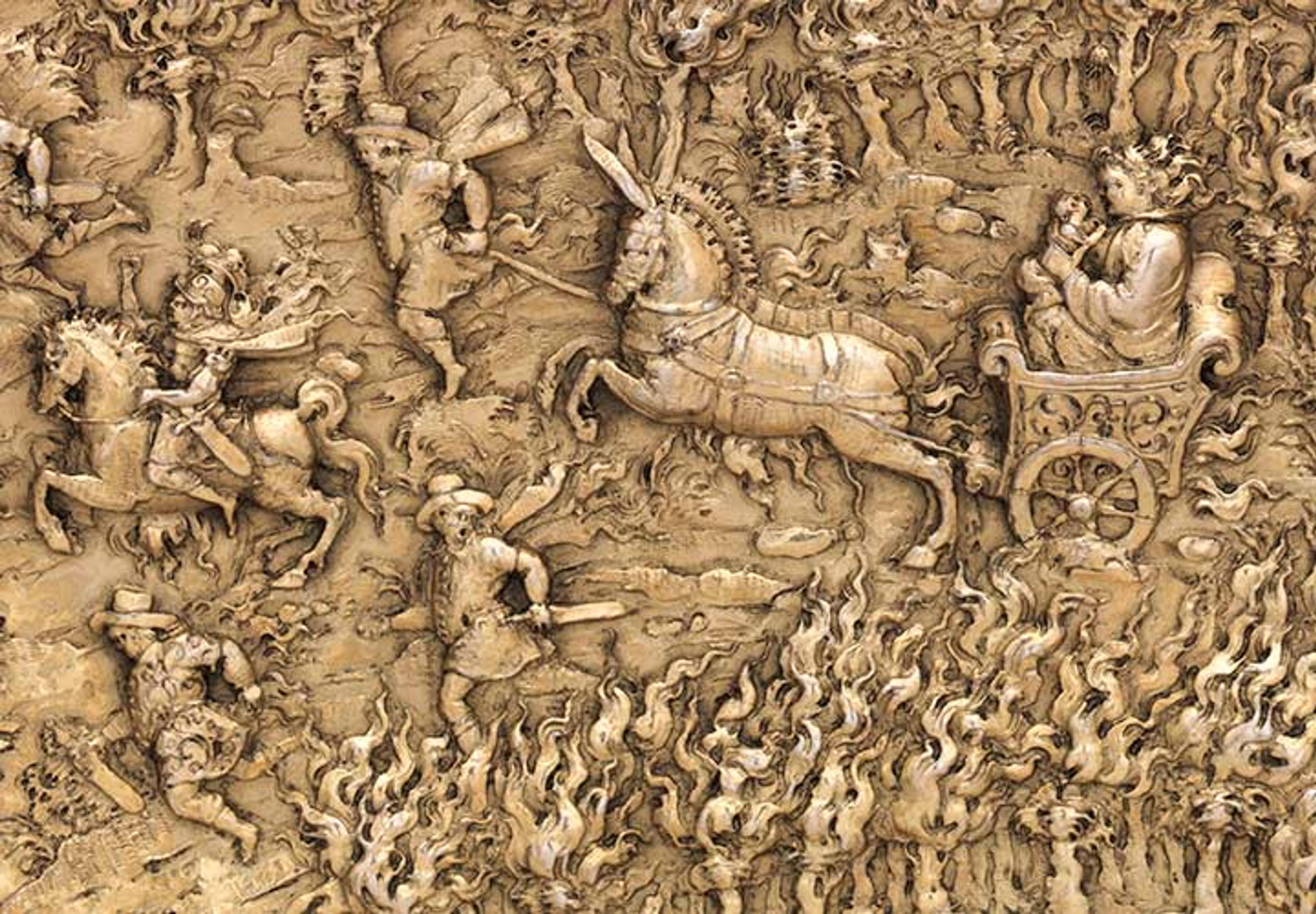
Detail from the Tiberius tazza
Leaving [Sparta] by night, [Tiberius] very nearly lost his life when flames suddenly burst out from the woods all along the way and engulfed the whole party, to the extent that part of Livia's clothes and hair was singed. —Suetonius 6
For me, the most wonderful thing on the Tiberius bowl [which they thought was the Domitian bowl] is not only the triumph we talked about before—which really does stand out for anyone who knows anything about Roman history—but this lovely picture of a woman in a chariot going somewhere. They clearly had terrible trouble finding what this could be, but eventually decided that Domitian's wife must have gone to visit him in Germany, which is never mentioned by Suetonius. What's more, it's absolutely bloody obvious when you look at it that this woman is surrounded by flames! She's going up in flames, and she's carrying a baby! A scene directly from the life of Tiberius.
At this point, you're seeing the infinite capacity of the human viewer to reinterpret according to instructions. You're also seeing someone who doesn't know the f*** about Suetonius. [laughter]
Sumi Hansen: In modern readings of imperial poetry such as the Aeneid, there's a school of dark readings where you can see the poets being critical of the regimes they're ostensibly celebrating. Can we read the cups this way?
Mary Beard: No. I think they are unusual in that. There is a lot of dark reading possible in Renaissance and later art. But you can look at the tazze till the cows come home, and the reading is overwhelmingly positive. One might expect this positive reading of the Caesars to be the norm, but actually it's much rarer than you think. This is, of course, a reading that any Renaissance guy reading Suetonius would recognize and understand. But that does not mean that the Renaissance was sitting down and reading Suetonius and to a man saying, "Yeah! Proper succession!" [laughter] I said we were looking at all the nasty stories? They were looking at them too.
Julia Siemon: One way to understand the tazze is to see them in the context of the Habsburg-controlled Netherlands of the 1590s as one of the gifts given to new rulers that were meant to model good behavior. Despite the fact that the Twelve Caesars were not normally used for this purpose, there is a tradition in the Renaissance of the "mirror of princes." When Archduke Albert arrived in the Netherlands he was given a tapestry series of scenes of Aeneas. Lipsius, a famous scholar in the same period, also gives Albert a book he has written on the magnificence of ancient Rome, the idea being that the prince will look at these gifts and learn good behavior.
Mary Beard: And more often than not, it's a complete failure! [laughter] So you're always seeing examples of the way you can recoup Rome to provide you the model of good rulership. But mostly, you know, the dark side can never be kept out. Look at what's-his-face's portrait with the coin of Nero! A wonderful, famous portrait by Memling of some unknown person holding up to the front of the canvas an absolutely well-copied coin of Nero. Now, is that because Nero's coins are very beautiful? [laughter] Is Rome generically a good example? Is it saying, "Careful, you don't want to turn out like Nero?" What is the coin doing there—with a very specific emperor on it whom no one has ever been able to think of as being good? I think that the question about what the relationship is between the emperor, the imperial image, imperial virtues, and modern behavior is always—I mean, I'm going to go for the dark reading of the Aeneid here. On the other hand, I think the tazze defy a dark reading.
Julia Siemon: They do.
Mary Beard: Absolutely defy a dark reading.
Julia Siemon: They don't allow it. An important component is that the scenes face inward towards the emperor. They're oriented towards the locus of power. So it's not the emperor showing you. He'sreceiving the positive message, which also makes them difficult to look at and adds to the challenge of reading them. It's literally the emperor looking down at his best behavior and receiving the accolades that result from it. So while there is a place for these readings that say to the emperor, "Don't do this, it won't work out," these are saying, "Do this. Model yourself on this behavior."
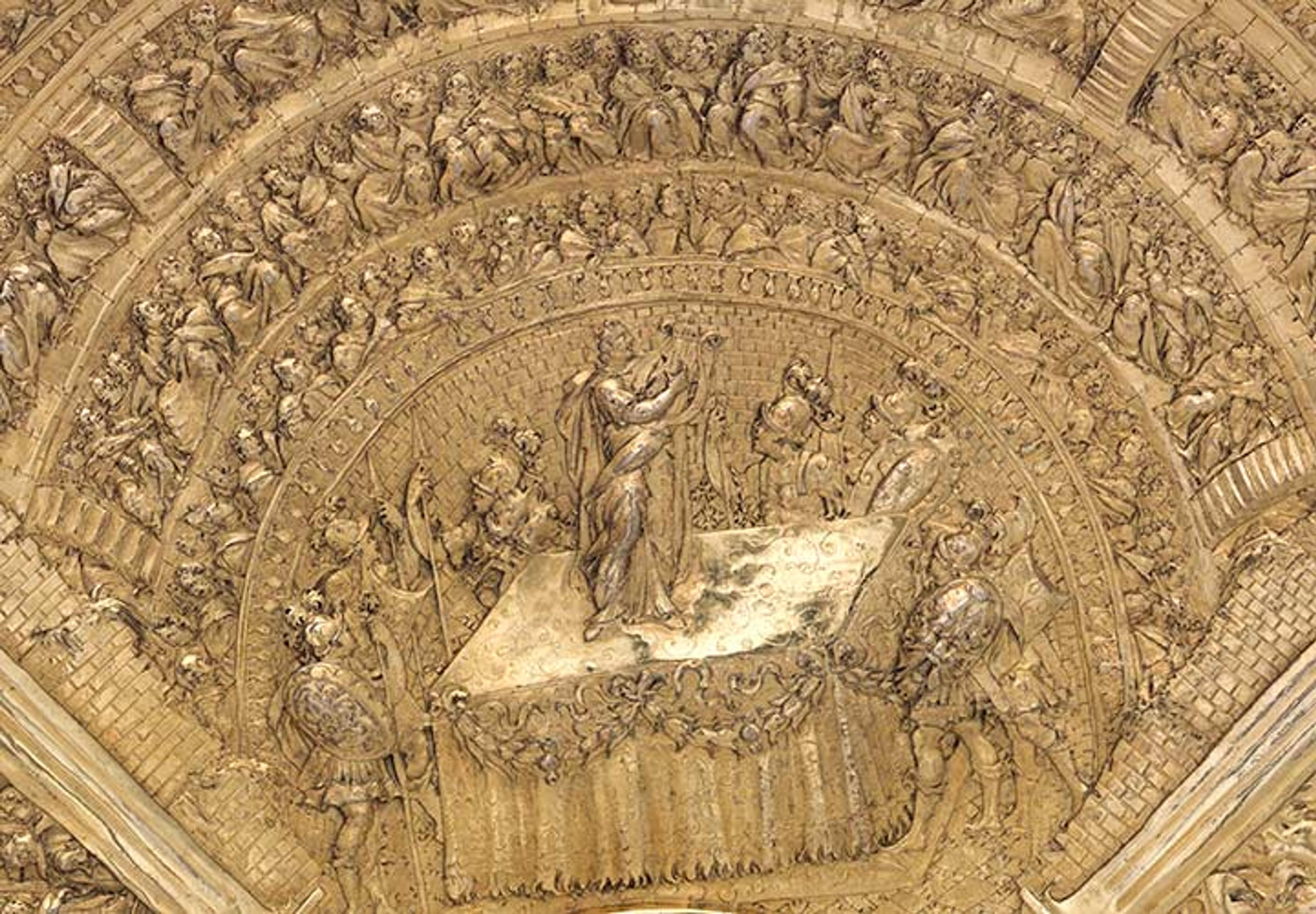
Detail from the Nero tazza
Although [Nero] had a feeble and husky voice, he was keen to appear on stage . . . and he first appeared at Naples, where—even though the theater was suddenly struck by an earthquake—he did not stop singing until he had finished the tune he had begun. In the same place, he performed frequently and for days on end. . . . —Suetonius 20–21
It's interesting that when the 16th-century scholar Erasmus publishes the stories of Suetonius, he gives the emperors mottos that are sort of plucked out of the text. For Nero, the motto that is, "Every land nurtures art." It's a struggle to find what's good about Nero, and the motto mispresents what Nero says, which is basically, "If Rome is burning, it doesn't really matter, because I can go somewhere else and play my music." Nero is flippant, but what comes out of it is his only virtue. He values art above all else.
Mary Beard: We read the triumph that Nero celebrates for his athletic victories in Suetonius as ironic. We say "Look! This is a parody for triumph. This is not a real triumph." Yet it is hard to see it as a parody on the Nero cup.
Julia Siemon: It's entirely earnest when you look at it without scrutinizing it and without thinking about what he's celebrating. Visually, it looks just like the others. It's presented as a legitimate triumph.
Sumi Hansen: On that note—about Nero, and the triumph of art—I believe we can end.
Note: This interview has been edited for publication.
Related Links
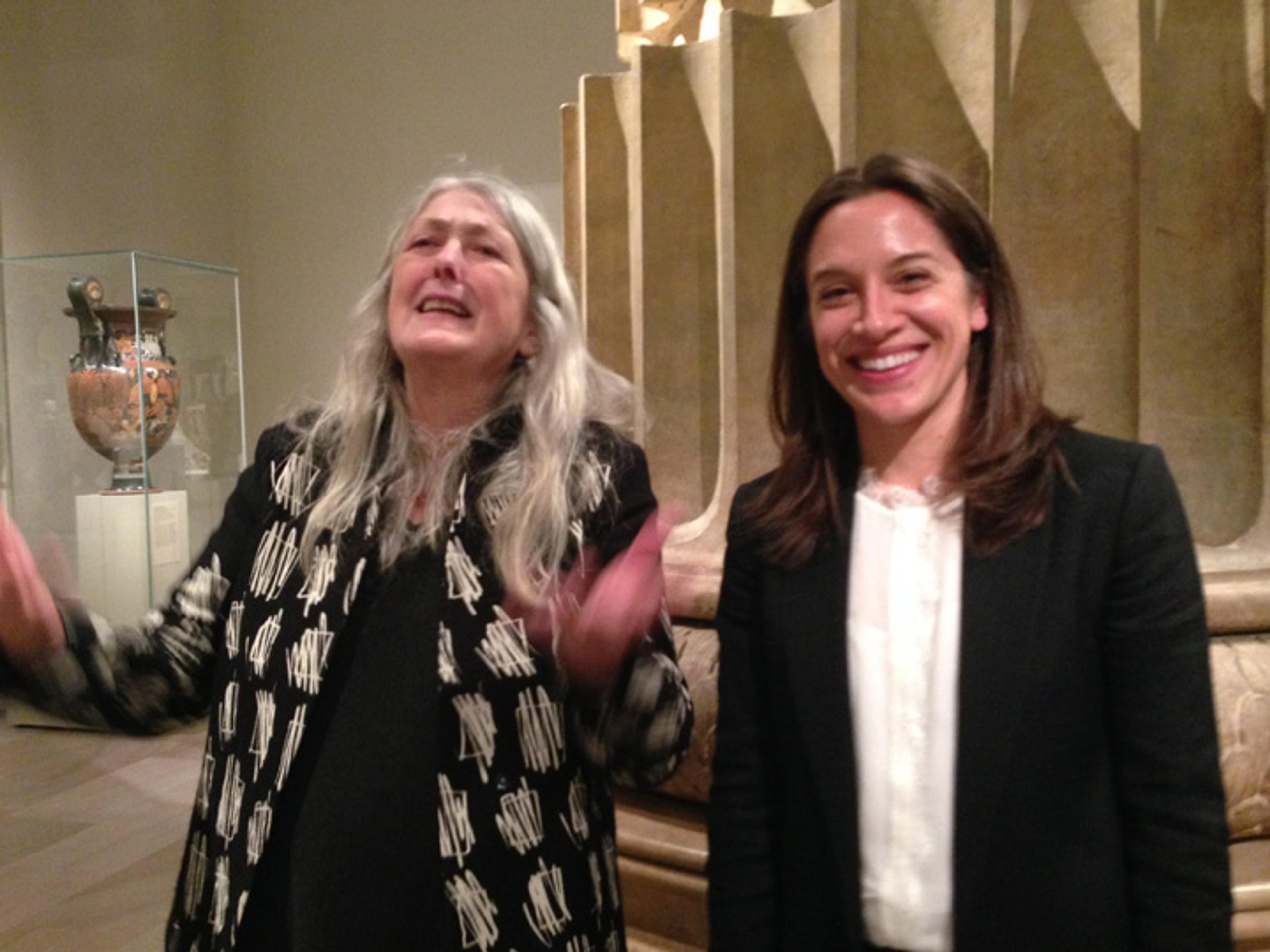
Now at The Met: "Decoding the Silver Caesars: A Conversation with Mary Beard and Julia Siemon, Part One"
The Silver Caesars: A Renaissance Mystery, on view at The Met Fifth Avenue through March 11, 2018
MetMedia: "The Nero Tazza"; "The Vitellius Tazza"